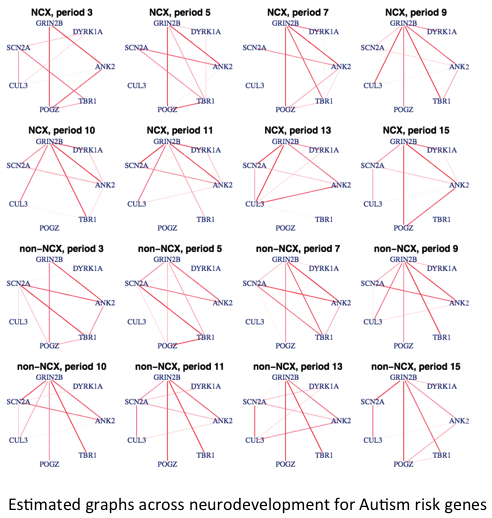Bayesian estimation of Gaussian Graphical Models
The analysis of biological networks, including protein-protein interaction networks (PPI), biological pathways, transcriptional regulatory networks and gene co-expression networks, has led to numerous advances in the understanding of the organization and functionality of biological systems.
In this work, we first propose a Bayesian neighborhood selection method to estimate Gaussian Graphical Models (GGMs). We show the graph selection consistency of this method in the sense that the posterior probability of the true model converges to one. When there are multiple groups of data available, instead of estimating the networks independently for each group, joint estimation of the networks may utilize the shared information among groups and lead to improved estimation for each individual network. Our method is extended to jointly estimate GGMs in multiple groups of data with complex structures, including spatial data, temporal data and data with both spatial and temporal structures. Markov random field (MRF) models are used to efficiently incorporate the complex data structures. We develop and implement an efficient algorithm for statistical inference that enables parallel computing. Simulation studies suggest that our approach achieves better accuracy in network estimation compared with methods not incorporating spatial and temporal dependencies when there are shared structures among the networks, and that it performs comparably well otherwise. Finally, we illustrate our method using the human brain gene expression microarray dataset, where the expression levels of genes are measured in different brain regions across multiple time periods.
Publication
In this work, we first propose a Bayesian neighborhood selection method to estimate Gaussian Graphical Models (GGMs). We show the graph selection consistency of this method in the sense that the posterior probability of the true model converges to one. When there are multiple groups of data available, instead of estimating the networks independently for each group, joint estimation of the networks may utilize the shared information among groups and lead to improved estimation for each individual network. Our method is extended to jointly estimate GGMs in multiple groups of data with complex structures, including spatial data, temporal data and data with both spatial and temporal structures. Markov random field (MRF) models are used to efficiently incorporate the complex data structures. We develop and implement an efficient algorithm for statistical inference that enables parallel computing. Simulation studies suggest that our approach achieves better accuracy in network estimation compared with methods not incorporating spatial and temporal dependencies when there are shared structures among the networks, and that it performs comparably well otherwise. Finally, we illustrate our method using the human brain gene expression microarray dataset, where the expression levels of genes are measured in different brain regions across multiple time periods.
Publication
- Lin Z, Wang T, Yang C, and Zhao H: On joint estimation of Gaussian graphical models for spatial and temporal data. Biometrics. 2017, 73: 769-779. [paper link] [software link]
